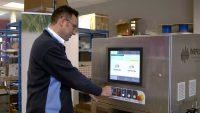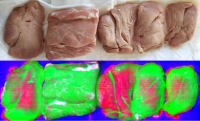Inndeo, a Spanish company founded in 2016, uses Specim’s hyperspectral imaging technology to improve the quality inspection processes in the food industry by increasing automation. With this new technology, they can detect contamination and defects in the production lines and characterise different food quality parameters.
From opportunity to an industrial partner:
In 2014, Daniel Artal and Emilio J. de la Red found a business opportunity to integrate new technologies into quality inspection automation. They learned that the industry manages these duties with traditional manual labor and machine vision equipment with limited detection capabilities. So they founded Inndeo in 2016, and in 2018 started to work with hyperspectral imaging to detect more complex contamination problems.
Currently, they develop and manufacture machine vision solutions for the food industry under the INSPECTRA brand. With their approach of selecting the most appropriate technologies to solve their customer’s quality problems and automate their production processes, they have gathered a clientele consisting of large Spanish food producers, especially in the meat sector.

Replacing manual labor and old equipment with sensor fusion
Today, food producers’ main fear is losing brand image above all the costs and repercussions of quality failures. The solutions companies use in the food sector are X-ray equipment, metal detectors, and even manual operators for certain defects. There are some artificial vision machines on the market, but most of them cannot detect defects beyond a comparison of a color palette.
INSPECTRA’s advantage is their integration of different technologies, sensor fusion, to improve the detection capabilities. One of the benefits is the digitalised quality and production data from the production lines. This high amount of data allows companies to apply BI techniques to rate their providers’ quality and detect production inefficiencies to improve their productivity.
Advancing from detecting defects and contamination to quality parameters
The main challenge was to choose the most suitable vision technology for each of their equipment to capture and process the images online.
Hyperspectral imaging allowed them to perform the most complex contamination detection outside the visible light spectrum. Like melted grease in the heat-sealed area of packages, it goes undetected by the human eye and other inspection technologies.
“The main reason we decided to implement hyperspectral imaging technology in our equipment was that no other technology was able to detect particular contamination and defects in the products and also characterise different quality parameters of the food”
Emilio J. de la Red, Chief Technical Innovation Officer of INSPECTRA
An added benefit was that they could classify different quality parameters from the food products with hyperspectral imaging.

The capture of hyperspectral images and the compose of chemical images requires a high load of computation. Moreover, integrating all that software in a robust machine that needs to work three shifts per day in a harsh environment was a challenge that required much hard work.
Both the use and the configuration of Specim cameras are simple in everyday life. They have the advantage of usability of a conventional camera despite being cameras with specific technology. The tricky part comes later, after the image capturing; the most challenging part is processing the images, associating the different spectral signatures, and obtaining the images in different tones according to the chemical composition.
Selecting the right partner
To succeed in integrating hyperspectral imaging into industrial equipment, INSPECTRA needed to choose the right partner. Specim is the world’s leading provider of hyperspectral imaging and is selected by numerous research laboratories, including world-renowned centers. This gave them the confidence to start the collaboration. The decision was easy when they learned the features and benefits Specim offered as a supplier.
“We have tested other suppliers for different types of technologies, but for hyperspectral imagining technology, we have trusted Specim since our beginning. We continue to work with them as a supplier to this day because they have always offered us the best solutions and have solved our problems very quickly whenever we have needed them.”
Emilio J de la Red
Excellent results
Specim technology has allowed them to detect different types of defects and contaminations, undetectable to the human eye and other technologies. They have successfully used hyperspectral imaging in many various applications:
- Contamination of heat-sealed packages
- Contamination in shrimp and different fish production lines
- The freshness of different products, meat, fish, vegetables
- Contamination and quality of wool
- Composition and contamination detection of various minced meats
- Quality and contamination detection in pork meat
For example, they use Specim FX17 camera to classify different defects from the meat samples. Detecting PSE (pale, soft, and exudative) defects from the meat samples are difficult to see with the naked eye. The same goes for both bones and tendons.

“Yes, the solution met our expectations because we could superficially detect defects in meat samples that were difficult to distinguish due to the similarity with shades in certain parts of the meat through this technology. In addition, this technology allows us to know the different chemical components of each product or element and thus assign them a different colour depending on their chemical composition.”
Emilio J de la Red
“We could detect foreign bodies, bleeding, PSE, tendons, bones, and cartilage in the samples without any problems. The only challenging defect is the holes in the meat. Hyperspectral cameras see the hole as an area of flesh (same material) but with shadow (less brightness).”
Emilio J de la Red
Endless amount of applications
The experience of working with Specim has been very satisfying for INSPECTRA. Both the cameras and the technology are easy to use and adapted perfectly to the different applications.
For the future, INSPECTRA is looking for native software from Specim, as the full integration into their machines has proven to be challenging with third-party software. However, given the multiple applications of the developed chemical image analysing technology, they will apply it to developing new equipment to detect contamination and quality inspection of many different food items. In addition, in the long-term future, they may build products with this technology for other sectors.
When asked what Emilio J. de la Red would like to say to other companies looking for a technology partner, he concludes:
“We would advise choosing Specim as a supplier of hyperspectral vision technology if they want to choose a supplier with solid experience, who offers a wide range of products to choose the technology that best suits their needs and offers excellent service and response time.”